Toyokan Hilights
The best collection of Asian art in Japan
Chinese Painting and CalligraphyChinese painting and calligraphy served as a model for the development of Japanese art, with paintings and calligraphic works from the Song and Yuan dynasties being regarded as a particular high point. Examples of these were brought to Japan by monks returning from study in China, or through trade activities in the early modern period. These examples include precious works in styles and genres that can no longer be found in China. The Tokyo National Museum collection of Chinese painting and calligraphy is unique among world museums. It focuses on Song- and Yuan-dynasty paintings such as those of the Higashiyama Gomotsu collection of the Ashikaga shogunate, and has been nurtured by the long history of exchange between Japan and China.
|
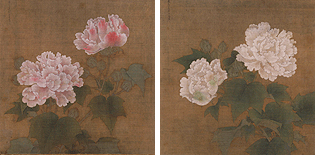 |
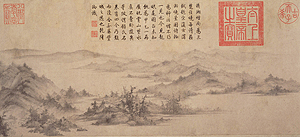 |
| Red and White Hibiscuses By Li Di Southern Song dynasty, dated 1197 National Treasure Li Di was a court painter in the Southern Song dynasty. This work, of hibiscuses changing color over time, represents a peak of realism in Asian painting. (on exhibit from January 2 to January 27, 2013, Room 8) |
Imaginary Tour through Xiaoxiang (Detail) By Li Southern Song dynasty, 12th century National Treasure The pale shades of ink draw the viewer into the world of this painting. This captivating work was formerly one of the four master scrolls owned by Emperor Qian Long. (on exhibit from January 2 to January 27, 2013, Room 8) |
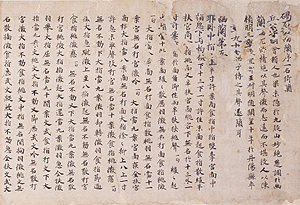 |
Youlan Tablature in Jieshi Diao (or “Stone Tablet”) Mode, vol. V (Detail) |
Chinese CeramicsThe architect Dr. Yokogawa Tamisuke donated over 1,100 items of Asian ceramics to the Tokyo National Museum over 7 occasions from 1932. The Chinese ceramics in his donations are of particularly high quality, and are known around the world as a leading collection in Japan. Around 80 years have passed since receiving his donations. With these historical ceramics as a foundation, the museum collection of Chinese ceramics continues to develop. Pottery shards and kiln tools are also scheduled to be displayed in the Toyokan.
|
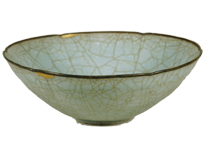 |
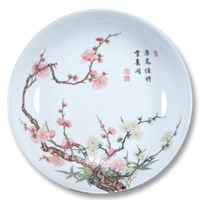 |
|
| Bowl with Foliate Rim, Celadon glaze Southern Song Guan ware, Southern Song dynasty, 12th - 13th century Important Cultural Property Gift of Dr. Yokogawa Tamisuke The deep color of celadon glaze, which changes with the light, is a highlight of ceramics from the Song-dynasty Guan kilns. (on exhibit from January 2 to May 6, 2013, Room 5) |
Dish, Plum tree design in famille rose enamel Qing dynasty, Yongzheng era (1723-35), China Important Cultural Property Gift of Dr. Yokogawa Tamisuke This dish is a representative example of ceramics that feature famille rose enamel, a decorative technique using lineless cloisonne methods from Europe. Ceramics made with this technique are commonly known as “kogetsuken” in Japanese. (on exhibit from January 2 to May 6, 2013, Room 5) |
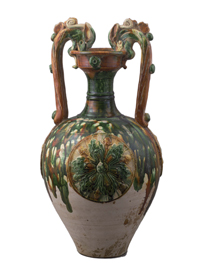 |
Vase with Dragon Handles, Three-color glaze Tang dynasty, 8th century Important Cultural Property Gift of Dr. Yokogawa Tamisuke Notable aspects of this vase are the florid colors and a unique shape suggesting the influence of Western culture. This celebrated work is a famous example of Tang-dynasty, three-color glazed sancai ware. (on exhibit from January 2 to May 6, 2013, Room 5) |
Chinese LacquerwareChinese lacquerware has a history that stretches back to the Neolithic period. The various decorative techniques of lacquerware include carving into layers of lacquer coat, applying inlays of cut seashells, filling carved designs in lacquered vessels with gold, and carving out outlines of designs applied in colored lacquer. Patterns include pictorial designs of landscapes, flowers-and-birds, pavilions, or figures, as well as scroll patterns that developed from arabesque motifs. Undecorated wares feature the simple beauty of a black or red lacquer coat. These works showcase the diversity of Chinese lacquerware.
|
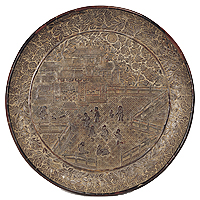 |
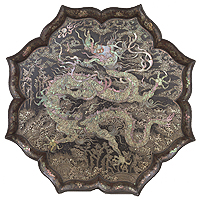 |
|
| Tray, Pavilion and figure design in black lacquer carving Southern Song dynasty, 12th – 13th century This tray’s design of people playing in front of a pavilion is carved into layers of black lacquer coat. The moon in the sky features the image of a rabbit, as believed in Chinese legend. (on exhibit from January 2 to March 24, 2013, Room 9) |
Foiled Tray, Dragon and wave design in mother-of-pearl inlay |
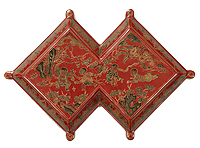 |
Covered Box, Boy design in gilded line engraving and colored lacquer inlay Ming dynasty, Jiajing era (1522–1566) This box is in the shape of two linked squares. The lid’s surface presents a colorful design of children playing. (on exhibit from January 2 to March 24, 2013, Room 9) |
Art of the Western Regions
To the west of China’s Yumen Pass and lining the northern and southern fringes of the Taklamakan Desert, ancient towns such as Turfan, Kucha, and Khotan were once oasis cities. At these places, Buddhist temples thrived and caravans of camels carrying goods rested during journeys. In the 20th century, Otani Kozui explored this region with the aim of discovering the area’s origins of Buddhism. The Western Regions collection of the Tokyo National Museum consists chiefly of objects brought back by the Otani expeditions. In this intriguing gallery, visitors can view artifacts from this region that was traversed by many merchants and monks, including the Chinese monk Xuanzang. |
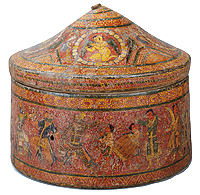 |
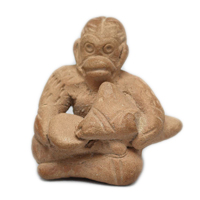 |
|
| Sarira Casket (Relic container) 6th - 7th century Subashi or Kumtura Grottoes, China, Otani collection This large-sized sarira casket is 38 cm in diameter. The lid features winged angels, while the sides are decorated with dancers wearing masks and playing instruments. (on exhibit from January 2 to February 24, 2013, Room 3)
|
Clay Figure 1st - 4th century Excavated at Yotkan, Khotan Otani collection Created from fired clay, this figure of a monkey is about 2cm tall. Many small figures such as this have been excavated from Yotkan, the capital of the ancient Khotan kingdom. (on exhibit from January 2 to February 24, 2013, Room 3) |
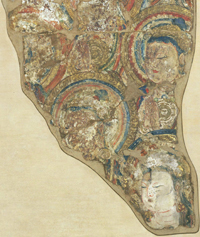 |
Fragment of Preaching Scene (Detail) Gaochang Uighur period, 10th - 11th century Bezeklik Grottoes, China Otani collection This section of mural is from the Bezeklik Grottoes, which were built to the northeast of Turfan. A host of bodhisattvas has been depicted using gold leaf and vivid colors. (on exhibit from January 2 to February 24, 2013, Room 3) |
